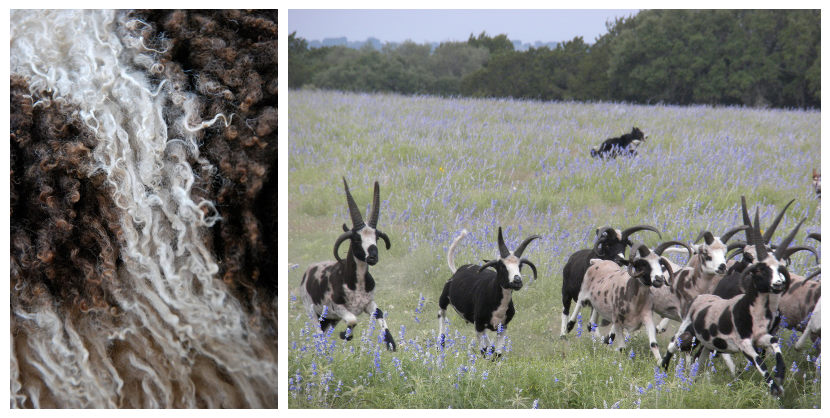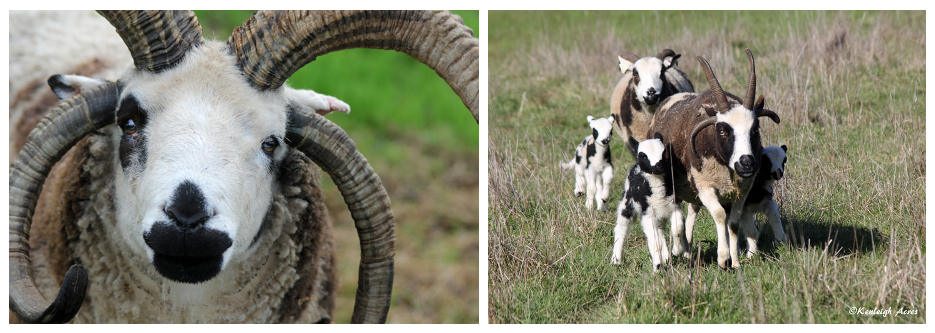Many elements should be taken into account when assessing the quality of a yarn and the most important of all is of course the fleece it is made from. Fleece – or wool – varies from one breed of sheep to another, carrying specific structural elements that impact the softness, strength and drape of the yarn. Knowing about the fleece produced by different breeds of sheep is a good way to understand what to look for when buying wool for a new project. Depending on the effect you want to achieve you might favour certain wool over some others.
In this second episode of Know Your Sheep we’re going to look at Jacobs, a primitive breed believed to be one of the oldest in the world.

- The History.
Primitive breeds have evolved from an evolutionary split that occurred before the development of modern breeds, and even though the exact geographical and genetic origins of the Jacobs remain widely unknown, most sources agree it would have first appeared in the Middle East before to be brought to Spain by the Moors, and finally reach the UK in the 16th Century.
Due to the mention of black and white spotted sheep in the Old Testament (Genesis 30:31), many believe the origin of the breed could be retraced to those times, however little genetic evidences can actually confirm this theory.
“I will go aboute all thy shepe this daye, and separate fro all the shepe that are spotted and of dyverse colours, and all blacke shepe among the lambes and the partie and spotted among the kyddes: And then such will be my reward.”
‘The fryst book of Moses, called Genesis’, William Tyndale, 1530.
The Chapter 30 of the Book of Genesis tells the story of Jacob who built his own flock from the black and white sheep given to him by his father-in-law. Few centuries later the breed was named after this biblical tale, although as we said earlier, there no existing evidence that can track the origin of Jacobs that far back in history.

All along the 17th and 18th centuries, the British landed gentry kept importing Jacobs from Spain, using them as ornamental sheep in the lands of their family estates. After the WWI the number of Jacobs in the UK slowly decreased to the point that they nearly completely disappeared during the first half of the century. Fortunately, the work of few enthusiastic breeders allowed Jacobs to survive and expand, leading to the foundation of the Jacob Sheep Society in 1969. With only 96 members and 2 700 registered sheep at the time, Jacob was classified as a minority breed.
For the past 40 years, Jacobs have been greatly improved providing hardy, long-lived animals, renowned for their high quality wool and the flavour of their meat. They are also very prolific with easy lambing attributes and good mothering qualities, which explain why the breed is also very successful in interbreed championship. Today the Society includes 850 members, with 2000 sheep added every year to their flock book.

2. The Wool.
Primitive breeds usually have a double-coated fleece, combining a hairy outer coat that protects the animal against snow and rain, while a fine inner coat works as an insulating layer next to the skin. Although being a primitive breed, Jacobs are not considered to be double-coated but medium-wool sheep as their fleece has an average fiber diameter varying between 25 and 33 microns, and doesn’t have any outer coat. Each animal show black and white patches, that gradually fade into brown throughout their life. Their wool is strong, lofty, semi-lustrous and silky, perfect to create hand-knitted garments, outerwear and blankets.
3. The Sheep.
Jacob sheep are medium size, finely boned and present a very distinctive appearance. They’re one of the rare polycerate breed, which means that both ewes and rams can produce either 2, 4 or – more rarely – 6 horns. The distribution of black patches over the fleece varies greatly from one sheep to another, however it shouldn’t be inferior to 15% but not exceed 85%. The head should be fairly narrow, clear of wool, with a definite white blaze delimited by black coloured cheeks. The ears are smalls and slightly above the horizontal. The fleece should be open with moderately developed crimp.
4. Yarns.
Due to the natural black and white colour of the fleece, Jacob wool is hugely popular amongst spinners and weavers, to create beautiful un-dyed yarns and textiles. Depending on how much black and white fleeces are blended together while spinning, it will create a great variety of shades ranging from pure white to pure black, with a multitude of greys in between. Due to its fairly wide fibre diameter, Jacob wool is hard-wearing which makes it really good for outerwear, although it is still fine enough to be used for all sorts of garments. Lofty fleece are also great to provide with bulkier, warmer fabric, and so you’re guaranteed to knit yourself something really cozy with it. The West Yorkshire Spinners is one of the rare manufacturer to produce yarn made out of 100% Jacob wool. The West Yorkshire Spinners – Jacobs Yarn DK Thickness is one of the firm favourite, so we’ve decided to dedicate an entire blog post about it, which should be up on the blog by the end of next week.
Maybe there is a specific breed of sheep you’d like to learn a little more about? If so, leave your suggestion in the comment box below!
Until Next Time… Happy Knitting!
SOURCE:
Fournier, Nola and Fournier, Jane, In Sheep’s Clothing: A Handspinner’s Guide to Wool, Loveland: Interweave Press LLC, 1995. Print
Satterfield, Monette L., Knitting and Crochet Combined, Waukesha: Kalmbach Publishing Co., 2007. Print.
The Breed, The Jacob Sheep Society, Web. http://www.jacobsheepsociety.co.uk/breed.htm
Why Choose Jacob Sheep?, The Jacob Sheep Society, Web. http://www.jacobsheepsociety.co.uk/why_choose_jacobs.htm
Breed Standard, The Jacob Sheep Society, Web. http://www.jacobsheepsociety.co.uk/breed_standard.htm
About Jacobs, Jacob Sheep, Web. http://www.jacobsheep.com/jacobs.htm
About Jacob Sheep, Jacob Sheep Breeders Association, Web. http://www.jsba.org/history.htm
JSBA Breed Standard, Jacob Sheep Breeders Association, Web. http://www.jsba.org/standard.htm
Selecting a Breed of Sheep, Sheep 201: A Beginner’s Guide to Raising Sheep, Web. http://www.sheep101.info/201/breedselection.htm





 No products in the basket.
No products in the basket.
excellent text! the text has interesting historic and bisblical references and give a good ideat about the Jacob ship and its wool.